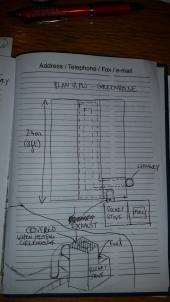Seth Hofstetter : While it is possible to split the flow of the hot exhaust gases down two sets of Horizontal piping within the thermal mass, and has been done anecdotally
one of the pipes will dominate, and you probably will never Know why! While there is potential for some savings in materials/parts not used, your design must be
clever to deliver such a savings!
A little physics, a little Math, when you start out with an 8 '' pipe with a Cross Sectional Area of 50.24 sq. in. and reduce its size to 4 '' pipe you end up with a Cross
Sectional Area of 12.56 sq. inches. Thats right, cut the size by 1/2, reduce the Area to a 1/4. Now even with (4) 4'' pipes having the same amount of sq. inches as one
8 inch pipe we are not flowing the same amount of material - liquid or gas - through them. This is because the ratio of the total surface area to the total volume
( 50.24 sq. inches ) is higher in the (4) 4 inch pipes, and we have to account for the higher frictional losses and loss of flow in the (4) 4 inch pipes !
If we take a Rocket mass heater RMH and give it a cross sectional area of 8'' we say we have a 8'' system. If at the Transitional Area (where the vertically falling Exhaust
Gases are funneled and turned at right angles) we divide the flow into (2) 6 inch pipes to flow into the horizontal chimney of the Cob Thermal Mass, they will each have a
Cross sectional area of ~28 inches~ with increased friction losses and a larger area in sq. inches to flow through we will have some slow down of gas flow ! This can be
dealt with by adding height to our Heat Riser and barrel and also by adding onto our final Vertical Chimney !
Anything that gives us the maximum reduction of the temperature of our hot exhaust gases ~140dF~ should be considered optimal, with an 8'' system that would be
about 40 feet, subtracting 5 ' for every elbow and 'T' in the system (a six inch System should run 30 ' w/ a subtraction of 5 ' for Elbows and 'T's) Any material lining ether
the Burn Tunnel or the Heat Riser and all of the Thermal mass should have walls as smooth as glass, rough walls will increase friction and decrease flow and distance !
It is always preferable to vent the final exhaust vertically to a point 3-5 feet above the peak of the roof or past the top of any other nearby tall object !
Steel is Doomed, it is unlikely that you will get through even one heating season with combustion zone parts made out of Steel, I am sure our fellow members will repeat
that for you regardless of what you may have seen on You-Tube !
I have no problem with a Thermal Mass made to be removable for one or two seasons! After two green house heating seasons if you have not finalized your RMH / Green
house design and switched to a more efficient Cob thermal mass you are just being lazy!

My Best piece of advice : Go to
rocketstoves.com to download your PDF Copy $18.oo of the brand new third addition of Ianto Evans' Great Book
'Rocket Mass Heaters'
with over 100,000 RMHs built world wide, most have been made following 'The Book', and 95% of all the 1st time builds (that worked!) were made from 'The Book' This
will allow you to speak the same language/vocabulary when speaking of the parts of the Rocket Mass Heater, its shape, size, and orientation to the other parts, and better
allow you to calculate the Specific Constant Cross Sectional Areas of all RMHs with No more than 5th grade math you will learn to Do in your head! The Time, Effort, and Monies
not wasted, will more than pay you back, and it will always be handy to refer to when reading these Forum Threads ! For the good of the Craft ! BiG AL





 1
1

























